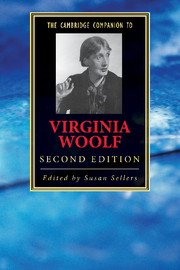Book contents
- Frontmatter
- 1 Bloomsbury
- 2 Virginia Woolf’s early novels: Finding a voice
- 3 From Mrs Dalloway to The Waves: New elegy and lyric experimentalism
- 4 The novels of the 1930s and the impact of history
- 5 Virginia Woolf’s essays
- 6 Virginia Woolf, modernism and modernity
- 7 The socio-political vision of the novels
- 8 Woolf’s feminism and feminism’s Woolf
- 9 Virginia Woolf and sexuality
- 10 Virginia Woolf, Empire and race
- 11 Virginia Woolf and visual culture
- 12 Virginia Woolf and the public sphere
- Guide to further reading
- Index
5 - Virginia Woolf’s essays
Published online by Cambridge University Press: 28 July 2010
- Frontmatter
- 1 Bloomsbury
- 2 Virginia Woolf’s early novels: Finding a voice
- 3 From Mrs Dalloway to The Waves: New elegy and lyric experimentalism
- 4 The novels of the 1930s and the impact of history
- 5 Virginia Woolf’s essays
- 6 Virginia Woolf, modernism and modernity
- 7 The socio-political vision of the novels
- 8 Woolf’s feminism and feminism’s Woolf
- 9 Virginia Woolf and sexuality
- 10 Virginia Woolf, Empire and race
- 11 Virginia Woolf and visual culture
- 12 Virginia Woolf and the public sphere
- Guide to further reading
- Index
Summary
The conversation Virginia Woolf has been having with her readers for over a hundred years now (her first publication was in 1904) has gone on changing, as conversations do. As a pioneer of reader-response theory, Virginia Woolf was extremely interested in the two-way dialogue between readers and writers. Books change their readers; they teach you how to read them. But readers also change books: 'Undoubtedly all writers are immensely influenced by the people who read them' ('Reading', 1919, E2, p. 157). Writers must adapt to changing conditions. Books alter as they are re-read: 'Even things in a book-case change if they are alive; we find ourselves wanting to meet them again; we find them altered' ('The Modern Essay', 1925, E4, p. 220). They are read differently by different generations: 'In 1930 we shall miss a great deal that was obvious to 1655; we shall see some things that the eighteenth century ignored.' Readers, therefore, need always to be aware of themselves not as isolated individuals, but as part of 'a long succession of readers' ('The Countess of Pembroke's Arcadia', CE1, p. 19), joining in the conversation.
In the dialogue between Woolf and her readers, a great variety of different Virginia Woolfs have come into being. A recent reincarnation (or 'renaissance') has been of Woolf as an essayist. Not that her writing of essays and journalism, which spanned her whole publishing career, has ever been ignored. But in recent years this aspect of her work has been read in new ways.
- Type
- Chapter
- Information
- The Cambridge Companion to Virginia Woolf , pp. 89 - 106Publisher: Cambridge University PressPrint publication year: 2010
- 2
- Cited by



